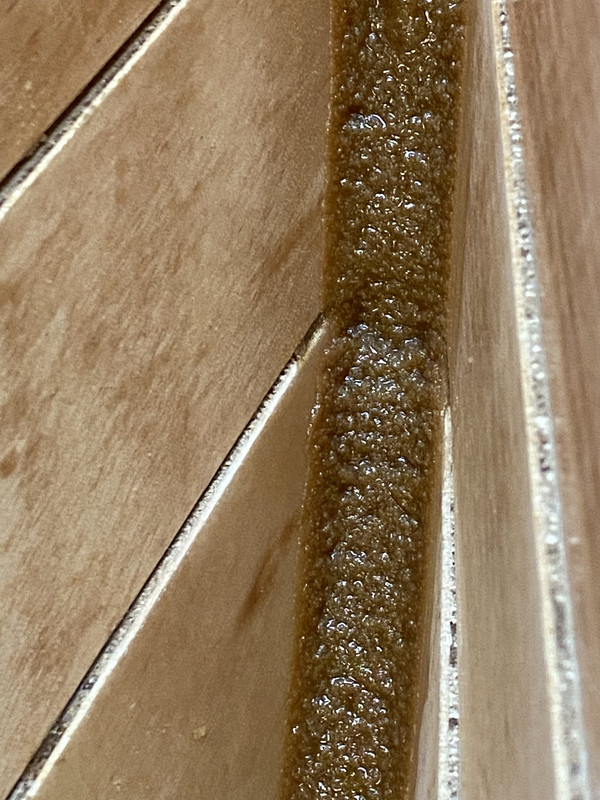Builders' Forum |
|
| ↓ Scroll to Last Comment ↓ | Forum Guidelines | Builders' Forum | |
I have built many stitch and glue boats. For all of those boats, I've thickened my epoxy for fillets with a 2:1 mix of cello-fill (or fumed silica) and wood flour. The instructions for this Annapolis Wherry tell me to just use wood flour. I tried this, and it looks awful-- like cellulite! I'm about to mix up a batch of the other, and smear it over the top. Am I doing something wrong? Why does it look like this?

3 replies:
RE: Thickened Epoxy Formulations
Just as each cook has their own recipe, so does each boatbuilder. Mine is entirely woodflour based because cab-o-sil makes fillets too brittle and hard to sand. I also have the philosphy that fillers should be a close match to the pieces of the joint for mechanical and thermal expansion reasons, so I don't use cellulose-based fillers like cello-fill, preferring instead the lignin-based chemistry of woodflour when joining wood.
The technique for getting a good smooth seam from woodflour is to first make the mix thick enough so it won't sag, as Howard says. That means stiffer and thicker mixes for vertical fillets than for horizontal and flat ones. The two ways to approach this are to either add more woodflour for vertical fillets or to rotate the boat to make vertical fillets into flat or horizontal ones.
That leads into the second important technique - smoothing the seam. Thick stiff woodflour mixes result in the grainy, rough surface that you have. Howard mentions gloved finger and denatured alcohol. That certainly works. Alternatively, my recipe is to use unthickened epoxy applied with a chip brush.
Using alcohol or another solvent depends on the applied solvent evaporating and leaving a clean surface. If the solvent is impure or some gets trapped below the surface of the epoxy where it can't evaporate, you end up with a contaminated joint. Unthickened epoxy is already an integral component, so there's no possibility of contamination. I find the chip brush easier to control. It results in a glass-smooth surface that needs very little, if any, finish sanding. When it does, it's for fairness, not smoothness, and it's much easier to sand than thickened epoxy.
If you're applying a cosmetic fillet over a rough one, rather than sanding it smooth, a mixture of phenolic microballoons and epoxy will give an easy to sand surface, as long as you're planing to paint, not varnish.
Good luck,
Laszlo
RE: Thickened Epoxy Formulations
Thanks, guys. I went back and applied a second layer while the first was still green. I used my filler powder mixture, which is a closer color match on this boat. (My Okoume from CLC is on the light end of the spectrum). I was not happy with the raduis of the initial fillet, so I had good justification for making a wider second swipe. Yeah, my first batch was a little saggy. The second batch was stiffer. Finally, I am aware of the the sanding difficulty when using pure cabo- or cello-fill. But the 2:1 ratio makes it more sandable.













RE: Thickened Epoxy Formulations
» Submitted by hspira - Sun, 12/20/20 » 2:04 AM
your not doing anything manifestly wrong....my experience on larger fillets is it can be challenging to get them nice and smooth.
fwiwi, i consider CLC's instructions sort of basic guides and not definitive. so if you have an approach that works reliably for you for fillets, i would follow that. while i don't have an exact prescription, like you, i start to mix cell-ofill into the mix to help get a smoother paste than what i can get with pure woodflour.
just eyeballing it, it looks like you don't have it thick enough to retain its shape....an issue that larger fillets are more sensitive too. doing a little practice piece like you were showing earlier may be a way to refine your recipe.
you can also take a doublegloved finger dipped in denatured alcohol as the epoxy is is still plasticy to smooth the surface of a fillet.
h